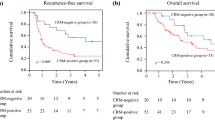Abstract
Background
Close circumferential resection margin (CRM) is an established predictor for locoregional recurrence (LR) in rectal cancer but remains controversial in esophageal malignancy. As yet, little is known about the significance of CRM after chemoradiotherapy (CRT), especially in squamous cell carcinoma (SCC). This study investigated the relationship between CRM distance and recurrence after neoadjuvant CRT in esophageal SCC patients.
Methods
Between 1997 and 2005, esophageal SCC patients who underwent surgery after neoadjuvant CRT and with pathology stage T3N0M0 and T3N1M0 (metastatic lymph nodes <2) were selected. CRM distance was reassessed and divided into three groups (group 1: CRM >1 mm, group 2: uninvolved CRM but <1 mm, group 3: CRM involved).
Results
The cohort comprised 145 male and 6 female patients with mean age of 57 years. There were 74, 51, and 26 patients in group 1, 2, and 3, respectively. With median follow-up period of 50 months, LR developed in 30.5% of patients. Both group 2 and group 3 had significantly higher LR than group 1 (37 and 42% vs. 21%, P < 0.05). Meanwhile, mean time from operation to recurrence was also significantly shorter in group 2 and group 3 than in group 1 (267 and 269 days versus 402 days, P < 0.05). Five-year disease-specific survival (DSS) was highest in group 1 (40%). Despite the similarity in LR, 5-year DSS significantly differed between group 2 and group 3 (22 vs. 7%, P < 0.05). The higher rate of distant recurrence (DR) and concomitant LR + DR in group 3 accounted for the survival difference.
Conclusion
In ypT3 esophageal SCC patients, CRM distance provides useful information for risk stratification in cancer recurrence and survival.


Similar content being viewed by others
References
Mariette C, Balon JM, Piessen G, et al. Pattern of recurrence following complete resection of esophageal carcinoma and factors predictive of recurrent disease. Cancer. 2003;97(7):1616–23.
Dresner SM, Wayman J, Shenfine J, et al. Pattern of recurrence following subtotal oesophagectomy with two field lymphadenectomy. Br J Surg. 2000;87(3):362–73.
Wibe A, Rendedal PR, Svensson E, et al. Prognostic significance of the circumferential resection margin following total mesorectal excision for rectal cancer. Br J Surg. 2002;89(3):327–34.
Fitzgibbons PL, Page DL, Weaver D, et al. Prognostic factors in breast cancer. College of American Pathologists Consensus Statement 1999. Arch Pathol Lab Med. 2000;124(7):966–78.
Adam IJ, Mohamdee MO, Martin IG, et al. Role of circumferential margin involvement in the local recurrence of rectal cancer. Lancet. 1994;344(8924):707–11.
Griffiths EA, Brummell Z, Gorthi G, et al. The prognostic value of circumferential resection margin involvement in oesophageal malignancy. Eur J Surg Oncol. 2006;32(4):413–9.
Deeter M, Dorer R, Kuppusamy MK, et al. Assessment of criteria and clinical significance of circumferential resection margins in esophageal cancer. Arch Surg. 2009;144(7):618–24.
Dexter SP, Sue-Ling H, McMahon MJ, et al. Circumferential resection margin involvement: an independent predictor of survival following surgery for oesophageal cancer. Gut. 2001;48(5):667–70.
Saha AK, Sutton C, Rotimi O, et al. Neoadjuvant chemotherapy and surgery for esophageal adenocarcinoma: prognostic value of circumferential resection margin and stratification of N1 category. Ann Surg Oncol. 2009;16(5):1364–70.
Sujendran V, Wheeler J, Baron R, et al. Effect of neoadjuvant chemotherapy on circumferential margin positivity and its impact on prognosis in patients with resectable oesophageal cancer. Br J Surg. 2008;95(2):191–4.
Rohatgi PR, Swisher SG, Correa AM, et al. Histologic subtypes as determinants of outcome in esophageal carcinoma patients with pathologic complete response after preoperative chemoradiotherapy. Cancer. 2006;106(3):552–8.
Chao YK, Chan SC, Liu YH, et al. Pretreatment T3-4 stage is an adverse prognostic factor in patients with esophageal squamous cell carcinoma who achieve pathological complete response following preoperative chemoradiotherapy. Ann Surg. 2009;249(3):392–6.
Royal College of Pathologists. Dataset for the histopathological reporting of oesophageal carcinoma. 2nd ed. London, England: The Royal College of Pathologists; 2006.
Edge SB, Byrd DR, Compton CC, et al. AJCC cancer staging manual. 7th ed. New York, NY: Spring-Verlag; 2010.
Spence GM, Graham AN, Mulholland K, et al. Bone marrow micrometastases and markers of angiogenesis in esophageal cancer. Ann Thorac Surg. 2004;78(6):1944–9; discussion 1950.
Roh MS, Lee JI, Choi PJ. Tumor budding as a useful prognostic marker in esophageal squamous cell carcinoma. Dis Esophagus. 2004;17(4):333–7.
Johansson J, DeMeester TR, Hagen JA, et al. En bloc vs transhiatal esophagectomy for stage T3 N1 adenocarcinoma of the distal esophagus. Arch Surg. 2004;139(6):627–31; discussion 631–633.
Tachibana M, Kinugasa S, Yoshimura H, et al. En-bloc esophagectomy for esophageal cancer. Am J Surg. 2004;188(3):254–60.
Khan OA, Fitzgerald JJ, Soomro I, et al. Prognostic significance of circumferential resection margin involvement following oesophagectomy for cancer. Br J Cancer. 2003;88(10):1549–52.
Rizzetto C, DeMeester SR, Hagen JA, et al. En bloc esophagectomy reduces local recurrence and improves survival compared with transhiatal resection after neoadjuvant therapy for esophageal adenocarcinoma. J Thorac Cardiovasc Surg. 2008;135(6):1228–36.
Acknowledgment
This study was supported in part by grant NSC 98-2314-B-182A-036 from the National Science Council, Executive Yuan, and in part by grant NMRPG380041 form the Chang Gung Memorial Hospital, Taiwan, Republic of China.
Author information
Authors and Affiliations
Corresponding author
Rights and permissions
About this article
Cite this article
Chao, YK., Yeh, CJ., Chang, HK. et al. Impact of Circumferential Resection Margin Distance on Locoregional Recurrence and Survival after Chemoradiotherapy in Esophageal Squamous Cell Carcinoma. Ann Surg Oncol 18, 529–534 (2011). https://doi.org/10.1245/s10434-010-1244-4
Received:
Published:
Issue Date:
DOI: https://doi.org/10.1245/s10434-010-1244-4




